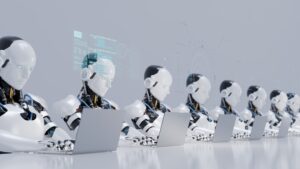Transforming Manufacturing: The Impact of AI-Driven Automation on the Future of Work in Dark Factories

The Rise of AI-Driven Automation: Exploring Dark Factories
In today’s fast-paced industrial landscape, artificial intelligence (AI) and automation are no longer futuristic concepts; they are actively reshaping how manufacturing operates. A prominent example of this transition is the emergence of dark factories, particularly in China, where facilities run entirely without human employees or traditional lighting. These factories utilize advanced robotics and AI technologies to operate continuously, offering unprecedented efficiency.
Understanding Dark Factories
Dark factories are fully automated production sites devoid of any human presence. The term "dark factory" stems from the absence of traditional lighting requirements since there are no workers on the factory floor. Instead, automated systems manage all aspects of production, such as assembly, quality control, and logistics. This approach not only mitigates the risk of human error but also reduces labor costs significantly, allowing for constant operation without breaks or fatigue.
One prime example of this innovation is Xiaomi’s smart factory located in Changping, China. This facility is capable of producing one smartphone every second, leveraging AI and robotics to optimize both efficiency and accuracy. Xiaomi has invested around $330 million in this plant, which spans an impressive 81,000 square meters and boasts an annual production capacity of 10 million units. The factory incorporates self-developed AI systems that monitor operations in real-time and conduct automatic maintenance tasks.
China’s push toward automation is part of its broader "Made in China 2025" strategy, aimed at positioning the country as a leader in high-tech manufacturing. In 2022, China accounted for 52% of the global total of newly installed industrial robots, a clear indication of its commitment to leveraging automation and AI in transforming its manufacturing sector.
Environmental Benefits of Automation
The integration of AI and robotics into dark factories supports not only efficiency but also environmental initiatives. With automation in place, there is a notable decrease in energy consumption since these factories eliminate the need for human-centered infrastructure like lighting and break areas. This operational model aligns with China’s carbon neutrality goals set for 2060, as improving energy efficiency is critical in various industrial sectors.
China’s Leadership in Industrial Automation
China stands at the forefront of industrial automation, fueled by its heavy investments in advanced technologies such as AI and robotics. As of 2023, China had a robot density of 470 robots for every 10,000 manufacturing workers, far surpassing the global average of 162 robots per 10,000 workers. Major corporations like Foxconn and BYD are pioneering this technological transformation, with Foxconn having automated 30% of its operations and previously replacing significant portions of its workforce with robots.
In terms of financial backing, China allocated roughly $1.4 billion to robotics research and development in 2023 alone, further propelling its trajectory toward automation. However, such rapid advancements raise concerns over job displacement, as many positions in manufacturing might be rendered obsolete. A report from Oxford Economics suggests that by 2030, up to 12 million manufacturing jobs in China could be at risk due to robotic automation.
Job Market Implications of Automation
The transition to dark factories poses significant implications for the workforce, particularly in manufacturing and logistics sectors. Many traditional jobs are threatened as machines take over tasks formerly performed by humans. According to forecasts from the World Economic Forum, automation could displace as many as 83 million jobs globally by 2027, particularly in roles related to assembly lines and warehousing.
While some roles are disappearing due to automation, new opportunities are also emerging. Fields in AI programming, robotics maintenance, and data analysis are projected to grow. The World Economic Forum estimates that approximately 69 million new jobs will emerge by 2027 in areas such as green energy and technology. Addressing the skills gap is crucial for ensuring that workers can transition into these new roles effectively.
To facilitate this shift, substantial investments in education and retraining programs will be essential. As job functions evolve from manual tasks to those requiring creativity and technical expertise, businesses and governments need to support workforce initiatives that help individuals acquire relevant skills.
Preparing for a Collaborative Future
Looking ahead, the future of work will likely be characterized by collaboration between humans and machines. While AI and robotics will handle repetitive and routine tasks, human involvement will remain vital in areas that require creativity, emotional intelligence, and problem-solving skills. Ensuring that workers are adequately prepared for these changes means focusing on educational programs that teach them to work alongside AI, ultimately enhancing their productivity and adaptability in an AI-driven economy.






